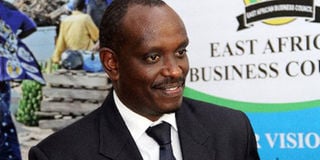EAC to develop draft political federation by end of October

East African Community Secretary-General Richard Sezibera. He on Tuesday said he had not been notified of the problem “although I have seen it dominant in the media coverage”. FILE PHOTO | NATION MEDIA GROUP.
What you need to know:
- Model will define the roles of the executive, legislative, judiciary as well as the EAC citizens
- member states have already made a lot of headway in achieving consensus
- East Africans need to work together in order to harness the benefits of regional
integration
The East Africa Community (EAC) member states will develop a draft political federation model by end of October.
Secretary General Richard Sezibera on Monday told journalists in Nairobi that the model will define the roles of the executive, legislative, judiciary as well as the EAC citizens.
"The model will then be presented to the EAC Council of Ministers, who will forward it to the Head of States during the EAC summit meeting later this year," Sezibera said during the opening ceremony of the Second EAC Annual Secretary General Forum on the private sector, civil society and other interest groups.
The two-day event brought over 200 delegates to discuss ways to enhance and strengthen partnership between the private sector and civil society in regional integration process. The EAC comprises of Kenya, Uganda, Tanzania, Burundi and Rwanda.
Sezibera said that member states have already made a lot of headway in achieving consensus on the building blocs of a political federation.
"There is a lot of agreement on peace, security, defense, good governance and corruption," he said. According to the EAC treaty which was signed in 1999, the ultimate goal of the economic bloc is to achieve a political federation.
GROWING ECONOMIES
The secretary general said that political unity among the member states will be people driven project. "The leaders will not decide for the EAC citizens," he said. He added that the civil society will play a critical role in ensuring the political federation.
"This will allow the member states to develop a sustainable strategy on how to build a united EAC that has many ethnic communities and religions," Sezibera said. "However, a political federation will allow the partner states to pull their sovereignties together," he said.
Kenya's EAC Cabinet Secretary Phyllis Kandie said that the establishment of the EAC was out of the realization that East Africans need to work together in order to harness the benefits of regional
integration.
Kandie noted that the EAC is now recognized as one of the fastest growing economies in the world due to the strong intra-EAC trade.
She noted that trading bloc is now working on developing legal binding mechanisms that will guide on how to deal with emerging non tariff barriers.
"This will assist in the smooth flow of goods and services across the borders," she said. EAC Deputy Secretary General Jesca Eriyo said that successful regional integration will require solid support by the citizens of the participating states.
"Such support will be based on the availability of full and complete information on all areas of integration," she said.
Eryo said that one of the key goals of the EAC is to ensure there is more balanced distribution of the benefits of integration a cross the member states.





